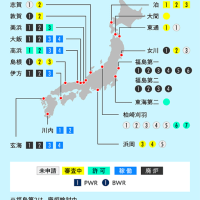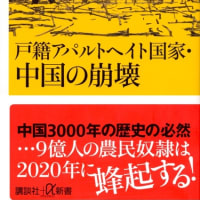"NO rubble wide area treatment: Reason " of :12 around the country's voices. 06/13/2012
(1) The rubble in which 'industrial waste, the chemical substance, and the heavy metal are contained cannot respond in a general incineration place.
'
Asbestos, arsenic, sexavalent chrome, PCB, etc. the industrial waste subject to special control, the chemical substance, and the heavy metal are contained in the rubble which arose according to the earthquake disaster, and these cannot be measured and classified completely.
The common incinerator does not correspond to processing of industrial waste.
Although the chemical substance of the level contained in common garbage and a heavy metal may be able to be processed by medicine processing etc., the total amount of these toxic substances contained in the rubble which arose according to the earthquake disaster is an unknown.
Therefore, incineration of such rubble is accompanied by a risk of reaching far and wide and causing diffusion of a toxic substance, and contamination.
(2) The rubble in which 'radioactive material is contained cannot respond in a general incineration place.
'
The contamination by a radioactive material reaches far and wide by the first nuclear power plant disaster of Fukushima.
And it is surmised for one year after an earthquake disaster that the radioactive material which descended by then to the rubble neglected on the outdoors has adhered.
you should manage and dispose of the radioactive waste severely essentially -- if it destroys by fire at a general incineration place -- incineration -- conduct -- there is a possibility that a work member may be contaminated and peripheral people may also be contaminated.
The bag filter of an incineration place does not correspond to incineration of radioactive waste.
In Fukushima Ichi, even if it uses a highly efficient bag filter, indication of having been detected in the chimney portion just before radioactive cesium is emitted into the atmosphere is carried out.
By the Osaka municipal assembly on February 22, this year, a possibility that about 36% is discharged by missing and remains and about 11% are discharged from the chimney by equipment of an incinerator etc. among the radioactive materials fed into the incinerator is pointed out the result examined based on trial calculation in the garbage processing plant in Ota-ku, Tokyo.
That is, even if the radioactive contamination of the rubble to take over is below a standard value, it will be said that an immense radioactive material is emitted to neighboring environment depending on the total amount of the rubble incinerated.
For example, it becomes 1 billion Bq in the radioactive cesium contained in the ashes which come out when 10,000 tons of rubble of 100 Bq/kg of radioactive cesium is incinerated, and a total amount.
If 0.01% leaks from the chimney of the space destroying by fire as very low trial calculation among the above and 1 billion-Bq cesium, 100,000 Bq will be emitted into the atmosphere.
In addition, while it will evaporate if the radioactive material adhering to rubble has a high temperature at the time of incineration, and being spread in the atmosphere, when the temperature at the time of incineration is low, the concentration to ashes progresses.
Therefore, management of a furnace will become difficult if incineration of rubble is begun.
In order to prevent contamination of a worker and neighboring residents as an institution polluted by radioactive waste at the time of filter exchange of a furnace, and demolition of a furnace, you have to take the severe measure against splash prevention.
Depending on the location of an incinerator, it will just be in charge of processing as nuclear waste in free [ of a residential street ].
This not only requires a huge amount of expenses, but the contamination risk of a worker or neighboring residents increases.
Furthermore, when explosion, a fire, etc. break out in an incineration place, broadly, it may disperse and a radioactive material may carry out a fallout.
In the worst case, it is also considered that the small-scale "1st nuclear power plant disaster of Fukushima" occurs.
Though natural, we are anxious also about the disposal method of incineration ashes.
Originally they require the nuclear waste disposal site for carrying out severe management.
However, the Ministry of Environment decided the plan which admits reclamation in a general final disposal site the case of 100,000 Bq or less so that it might mention later by (4).
In the self-governing body which inconsistency with a nuclear regulation method is not only pointed out, but carried this out, serious environmental pollution is already checked.
For example, in the south this Maki final disposal site in Yokohama-shi, Kanagawa which is performing sea surface reclamation, that 1 million Bq per day (it is 130 million Bq in a little more than four months) radioactive cesium was emitted to the Yokohama harbor by the municipal assembly in March, this year It was clarified.
Since it is easy to elute radioactive cesium in water, if sea surface reclamation of the fly ash containing it is carried out, marine contamination may get worse.
(3) There is a defect in 'radioactive contamination inspection and it cannot secure safety.
'
Most present radioactive contamination inspections have made only the gamma ray nuclide the object.
Safety cannot be ensured without carrying out measurement of radioactive plutonium, radiostrontium, etc. with strong toxicity, alpha line nuclide, and a beta ray nuclide.
A gamma ray nuclide can also be un-detecting depending on upvaluation and measuring time shortening of a minimum-limit-of-detection value.
And pollution investigation of rubble is a sample survey.
A trial calculation may be made quite lower than actual degree of contamination the case where the rubble in which advanced contamination is guessed is excepted from a sample survey.
If the rubble total amount incinerated increases also noting that the inspected rubble is 100 Bq/kg or less of a standard value, in it, a quantity of radioactive nuclide will also increase according to it.
Keeping the standard value per weight does not necessarily secure safety.
In addition, a space dosimeter is held up to rubble as performance which advertizes the safety of rubble, and it may be claimed that a rise is not seen.
The degree of contamination of rubble cannot be measured with a space dosimeter.
Space dosimeters are 0 and 01microSv. If it seems that it goes up, the rubble will be a 10,000 Bq/kg several 100? number. There is a possibility of being polluted.
100 Bq/kg In order to conduct pollution analysis of a grade, analysis with a germanium semiconductor measuring instrument is indispensable.
(4) There is a problem of a double standard (double standard) which is contradictory to 'nuclear regulation method.
'
By the nuclear regulation method, kg is appointed at the clearance level in 100 Bq /with radioactive cesium as disposal of the radioactive waste in nuclear installation.
And discarding in addition to also moving this except the handling administrator who has radioactive waste, regulation, and qualification for the contaminant beyond it, and a radioactive waste final disposal site has also forbidden firmly.
This standard is established from a viewpoint of safety.
On the other hand, the standard from which the Ministry of Environment makes wastes after the Fukushima nuclear power plant disaster, incineration ashes, etc. about the wide area treatment of rubble, and a self-governing body reclaims land in a disposal site, it is considered as radioactive cesium of 8000 Bq/kg or less -- the plan which admits reclamation in the final disposal site where the case of 100,000 Bq or less is also general was decided further on August 27, 11.
This is contradictory to a nuclear regulation method, and is considered that it should generally make severer the standard of the common place outside the standard in nuclear installation.
Governor Masanori Tanimoto of Ishikawa Prefecture, "Isn't it a double standard?
It says that now, residents are not convinced", and there is open distrust.
(5) The wide area treatment of 'rubble is provided from national expenditure, and suppresses a disaster victim aid budget.
The wide area treatment of 'rubble is provided from national expenditure, and suppresses a disaster victim aid budget.
The wide area treatment of rubble also requires the stricken area head who is presenting the question.
Mayor Date Katumi of Iwaizumi-cho, Iwate, It says, "Where is the necessity that the land which is not used carries out all over the country those with full, and not being troubled even if not processed using a tax sky-high?"
In the Kobe earthquake, Kobe corresponded to rubble processing by extending an incinerator.
However, the plant of a rubble processing speciality is made to Mayor Toba of Rikuzen-Takata-shi, Iwate, and in the city, when a prefecture is consulted with on a plan to process by one numbers of times the speed of this, there is a complicated procedure in the current law, and it has testified for having been turned away for the reason it takes 2 year to construction even if permission comes out.
If it is safe rubble which can be incinerated satisfactorily, a temporary incinerator is made there, and it is [ way ] economical and useful for revival from the field of employment.
on the other hand, it is dangerous rubble which cannot be incinerated there -- it is necessary to consider another ways of coping called reclaiming land shut up with concrete
In addition, you should not take a risk of expanding contamination by carrying far away in this case.
A huge amount of transportation costs and processing expenses start wide area treatment, and all are provided from national expenditure.
However, they become more effective [ support / turn / to a disaster victim or a stricken area / directly ] rather than [ that the self-governing body which has not suffered a great deal of damage receives those expenses ].
「NO瓦礫広域処理::12の理由」 around the country's voices. 06/13/2012
(1)'産業廃棄物、化学物質、重金属が含まれている瓦礫は、一般焼却所で対応できない。'
震災によって生じた瓦礫には、アスベスト、ヒ素、六価クロム、PCBなどの、 特別管理産業廃棄物、化学物質、重金属が含まれており、これらを完全に測定、分別することはできません。 一般の焼却炉は、産業廃棄物の処理に対応していません。 一般ゴミに含まれるレベルの化学物質、重金属は、薬剤処理などで処理できる可能性がありますが、 震災によって生じた瓦礫に含まれる、それら有害物質の総量は、未知数です。 したがって、そのような瓦礫の焼却は、有害物質の拡散、汚染を広範囲にわたって引き起こすリスクを伴います。
(2)'放射性物質が含まれる瓦礫は、一般焼却所で対応できない。'
福島第一原発事故により、放射性物質による汚染は広範囲に及んでいます。 しかも、震災後、一年の間、屋外に放置された瓦礫には、 それまでに降下した放射性物質が付着していると推測されます。 放射性廃棄物は、本来、厳重に管理・処分すべきであり、 一般焼却場で焼却すると、焼却所作業員が被曝し、周辺住民も被曝するおそれがあります。 焼却所のバグフィルターは、放射性廃棄物の焼却に対応していません。 福島市では、高機能のバグフィルターを使っても、 放射性セシウムが大気中に放出される寸前の煙突部分で検出されたという指摘がされています。 今年2月22日の大阪市議会では、東京都大田区の清掃工場での試算に基づいて検討した結果、 焼却炉に投入された放射性物質のうち約36%が行方不明になり、 焼却炉などの設備に残留、および、約11%が煙突から排出されている可能性が指摘されています。 つまり、引き受ける瓦礫の放射能汚染が基準値以下であっても、 焼却される瓦礫の総量によっては、莫大な放射性物質が近隣環境に放出されるということになります。 たとえば、放射性セシウム100ベクレル/kgの瓦礫を1万トン焼却したときに出る灰に含まれる放射性セシウムは、 総量で10億ベクレルになります。 上記、10億ベクレルのセシウムのうち、きわめて低い試算として0.01%が焼却場の煙突から漏れると、 大気中に10万ベクレルが放出されることになります。 なお、瓦礫に付着した放射性物質は、焼却時の温度が高いと気化して大気中に拡散される一方、 焼却時の温度が低い場合は、灰への濃縮が進みます。 そのため、瓦礫の焼却を始めると、炉の管理が困難になります。 炉のフィルター交換や、炉の解体時には、放射性廃棄物に汚染された施設として、 作業員や近隣住民の被曝を防ぐために、厳重な飛散防止対策を講じなければなりません。 焼却炉の立地によっては、まさに住宅街のただ中の核廃棄物として、処理にあたることになります。 これは膨大な費用がかかるだけでなく、作業員や近隣住民の被曝リスクが高まります。 さらに、もし焼却所で爆発、火災等が発生した場合は、広範囲に放射性物質が飛散、降灰する可能性があります。 最悪の場合、小規模な「福島第1原発事故」が発生することも考えられます。 当然ながら、焼却灰の処分法も懸念されます。 それらは、本来、厳重管理するための、核廃棄物処分場を要するものです。 しかし、(4)で後述するように、環境省は10万ベクレル以下の場合は、 一般の最終処分場で埋め立てを容認する方針を決めました。 これは、原子力規制法との矛盾が指摘されているだけでなく、 実施した自治体では、すでに深刻な環境汚染が確認されています。 たとえば、海面埋立をおこなっている神奈川県横浜市の南本牧最終処分場では、今年3月の市議会で、 一日あたり100万ベクレル(4ヶ月強で1億3000万ベクレル)の放射性セシウムが横浜港に放出されていたことが 明らかにされました。 放射性セシウムは水に溶出しやすいため、それを含む飛灰を海面埋立すると、海の汚染が進む可能性があります。
(3)'放射能汚染検査には不備があり、安全性を確保できない。'
現状の放射能汚染検査のほとんどは、γ線核種しか対象にしていません。 強い毒性のある、放射性プルトニウム、放射性ストロンチウムなど、 α線核種とβ線核種の測定をせずに安全を確保することはできません。 γ線核種も、検出下限値の切り上げや、測定時間短縮によっては、不検出になりえます。 しかも、瓦礫の汚染調査は、サンプル調査です。 高度汚染が推測される瓦礫が、サンプル調査から除外された場合、 実際の汚染度よりかなり低く試算される可能性があります。 かりに、検査された瓦礫が、基準値の100ベクレル/kg 以下であったとしても、 焼却される瓦礫総量が増えれば、放射性物質量もそれに応じて多くなります。 重量あたりの基準値を守ることは、必ずしも安全を保障しません。 なお、瓦礫の安全性をアピールするパフォーマンスとして、 瓦礫に空間線量計をかざし、上昇が見られないと主張されることがあります。 瓦礫の汚染度は、空間線量計では測定できません。 空間線量計が 0,01μSv 上昇するようであれば、 その瓦礫は数百~数万ベクレル/kg 汚染されている可能性があります。 100ベクレル/kg 程度の汚染分析はをおこなうには、ゲルマニウム半導体計測器での分析が必須です。
(4)'原子力規制法と矛盾する、ダブルスタンダード(二重基準)の問題がある。'
原子力規制法では、原子力施設内における放射性廃棄物の処置として、 放射性セシウムでは100ベクレル/Kgをクリアランスレベルと定めています。 そして、それ以上の汚染物を放射性廃棄物と規定、 資格を持つ取扱管理者以外がこれを移動することも、 放射性廃棄物最終処分場以外に廃棄することも固く禁止しています。 この基準は安全の観点から定められています。 一方、瓦礫の広域処理について、 環境省は福島原発事故後、焼却灰などを一般廃棄物として自治体が処分場に埋め立てる基準を、 放射性セシウム8000ベクレル/Kg以下とし、 さらに11年8月27日には、10万ベクレル以下の場合も一般の最終処分場で埋め立てを容認する方針を決めました。 これは原子力規制法と矛盾しますし、 一般的には、原子力施設内の基準より、外の一般地の基準はより厳しくするべきであると考えられます。 石川県の谷本正憲知事は、 「ダブルスタンダードではないか。これでは住民は納得しない」と語り、不信感をあらわにしています。
(5)'瓦礫の広域処理は国費から賄われ、被災者支援予算を圧迫する。'
瓦礫の広域処理は国費から賄われ、被災者支援予算を圧迫する。 瓦礫の広域処理には、疑問を呈している被災地首長もいます。 岩手県岩泉町の伊達勝身町長は、 「使ってない土地がいっぱいあり、処理されなくても困らないのに、 税金を青天井に使って全国に運び出す必要がどこにあるのか。」と述べています。 阪神淡路大震災では、神戸市は焼却炉を増設することにより、瓦礫処理に対応しました。 ところが、岩手県陸前高田市の戸羽市長は、 市内に瓦礫処理専門のプラントを作り、何倍ものスピードで処理する計画を県に相談したところ、 現行法には煩雑な手続きがあり、許可が出ても建設まで二年かかるという理由で、 門前払いされたことを証言しています。 問題なく焼却できる安全な瓦礫なら、 現地に仮設焼却炉を作るほうが経済的で、雇用の面から復興に役立ちます。 一方、現地でも焼却できない危険な瓦礫なら、 コンクリートで閉じ込める、埋め立てるといった、別の対処法を考える必要があります。 なお、この際、遠方に運搬することによって汚染を拡大するリスクはとるべきではありません。 広域処理には膨大な輸送費や処理費がかかり、すべて国費からまかなわれます。 しかし、それらの費用は、被災していない自治体が受け取るより、 被災者や被災地に直接まわすほうが、より有効な支援になります。
(6) It is not the main causes of the delay in rubble disposal that 'wide area processing does not progress.
Although Environment Minister Toshiyuki Hosono is saying that rubble processing of disaster 3 prefectures is progressing only 5%, the rubble turned to broader-based processing is only 20% of a rubble total amount also a government program.
That is, although broader-based processing progresses to a loan half, a processing rate only increases by 10%.
The main causes of the delay in rubble disposal are not that broader-based processing does not progress.
Furthermore, broader-based processing cannot be asked for the reason which is behind in revival.
(7) 'wide area processings are the constitution and violation of the Local Government Act.
'
Special Measures Law which receives the first nuclear power plant disaster of Fukushima a " fourth article municipal corporation is related with dealing with contamination of the environment by an accident origin radioactive material -- according to the natural social conditions of the area concerned, it shall play a suitable role through the cooperation in a measure of a country -- " -- it is.
This infringes the constitution which sings the main object of local autonomy, and infringes the Local Government Act which defined the principle of autonomy and resident autonomy.
(8) 'wide area processing is contrary to international agreement.
based on international agreement, you should manage the waste containing 'radioactive material -- if it says with the essential principles of IAEA, diffusion should be prevented and central control should be carried out.
If radioactive waste is incinerated, the vaporized radioactive material will be in an air current, and contamination will spread across the border.
If broader-based processing is advanced, Japan will take the responsibility for global environmental pollution.
(9) 'wide area processing is morally contrary.
'
Toden which is a first meaning person in charge should take over all the radioactive waste that occurred by the Fukushima nuclear power plant disaster.
Such a big problem group is not taken up, but even if it considers hammering out rubble acceptance within the prefecture in the front, and future prefectural government, a question arises.
Locus of responsibility is made ambiguous and taking over the rubble polluted by radioactivity and a precedent in which a detached island accepts radioactive waste may be set.
(10) There are 'Okinawa, therefore a possible possibility of stricken area support.
As land with little fallout (descent of a radioactive material) to 'Okinawa, the value is figured out and is not found.
Those who ask for the agricultural products from a prefecture, and those who visit as a settlement and a health resort will increase in number from now on.
Okinawa can support stricken area revival through production increase of the radioactivity-free agricultural products from a prefecture, development and production increase of health food, maintenance of a health resort, a refuge person's acceptance, etc.
(11) The acceptance of 'rubble cannot say it as the policy focused on Okinawa residents.
If 'pollution rubble is processed in a general incineration place, a certain amount of profits will be expected by the industrial waste treatment company within the prefecture, but the general people of the prefecture are only saddled with a risk and uneasiness, and have almost no profits.
The influence which radioactive waste brings to environment also attains to the children born to Okinawa from now on.
some radioactive materials require tens of thousands of years of time until toxicity disappears -- even if it prepares the disposal site where the degree of sealing is high, safety over the future cannot be secured.
If spread to groundwater, how to give a hand should be lost.
Acceptance of rubble increases the anxiety over a delivery and child-rearing, and causes the young people's of the prefecture outflow.
Moreover, acceptance of rubble leads to a damage to image of Okinawa now when people of Japanese every place are interested in the radioactive contamination problem.
Also to the tourist business which is a major industry, the expectation for the big agricultural products a damage and from Okinawa and health food will also be reduced.
(12) -- rubble incineration in 'Naha and a Haebaru clean center -- the health of a worker or residents -- and
A huge risk follows about the economic loss by contamination of a metal or slag.
Since 'Naha and a Haebaru clean center are proud of state-of-the-art equipment and remaining power is in burning capacity, it is considered to be one of the major candidates as a waste incineration plant of the rubble which arose by the earthquake disaster.
but the clean center is located in a population high density area, and two or more schools and hospitals are located immediately in a side -- damage will become serious when an accident occurs.
furthermore, a metal and slag are recycled from the incineration ashes of the clean center -- the income which is 130 million yen per year is brought about.
Since a radioactive material will be condensed in process of incineration even if it is contamination below a standard value if rubble is incinerated, there is a risk of a metal and slag being polluted highly.
The slag which melts and makes incineration ashes is processed at the temperature over 1300 ℃, and may be heated to 1600 ℃ depending on a furnace.
It has not been investigated yet whether the strontium evaporated at 1382 ℃ by the process can filter with a filter.
Therefore, once it receives rubble, the necessity of investigating the degree of contamination of a metal or slag will arise, and it will become an excessive financial burden.
Moreover, when contamination is revealed in a loan, there is also a demerit that the income which must have been obtained decreases.
(6)'広域処理が進まないことは、瓦礫処分の遅れの主な原因ではない。,
細野豪志環境相は、被災三県の瓦礫処理が五パーセントしか進んでいないと語っていますが、 広域処理に回される瓦礫は、政府計画でも瓦礫総量の20パーセントにすぎません。 つまり、かりに広域処理が半分進んでも、処理率は10パーセント上がるにすぎないのです。 瓦礫処分の遅れの主な原因は、広域処理が進まないことではありません。 まして、復興が遅れている理由を、広域処理に求めることはできません。
(7)'広域処理は憲法・地方自治法違反である。'
福島第一原発事故を受けての特別措置法では、 「第四条 地方公共団体は、事故由来放射性物質による環境の汚染への対処に関し、 国の施策への協力を通じて、当該地域の自然的社会的条件に応じ、適切な役割を果たすものとする」とあります。 これは、地方自治の本旨をうたう憲法に反し、団体自治と住民自治という原則を定めた地方自治法に反します。
(8)'広域処理は、国際合意に反する。'
放射性物質を含む廃棄物は、国際合意に基づいて管理すべきであり、 IAEAの基本原則でいえば、拡散を防止して集中管理をするべきです。 放射性廃棄物を焼却すると、気化した放射性物質は気流にのり、国境を越えて汚染が広がります。 広域処理を進めるなら、日本は地球規模の環境汚染の責任を負うことになります。
(9)'広域処理は、道義的に反する。'
福島原発事故によって発生した放射性廃棄物は、すべて第一義的な責任者である東電が引き取るべきものです。 そうした大きな問題群を取りあげず、県内への瓦礫受け入れを前面に打ち出すことは、 将来の県政を考えても疑問が生じます。 責任の所在を曖昧にし、放射能に汚染された瓦礫を引き受けることは、 放射性廃棄物を離島が受け入れる前例となりかねません。
(10)'沖縄だからこそ可能な、被災地支援の可能性がある。'
沖縄は、フォールアウト(放射性物質の降下)が少ない土地として、その価値ははかりしれません。 県産の農産物を求める人や、移住地、保養地として訪れる人は、今後増えるでしょう。 沖縄は、放射能フリーの県産農産物の増産、健康食品の開発・増産、保養地の整備、 避難者の受け入れなどを通して、被災地復興を支えることができます。
(11)'瓦礫の受け入れは、沖縄県民重視の政策とはいえない。'
汚染瓦礫を一般焼却所で処理すると、県内の産廃業者にはある程度の利益が見込まれますが、 一般県民はリスクと不安を背負い込むだけで、ほぼ何も利益がありません。 放射性廃棄物が環境にもたらす影響は、今後沖縄に生まれる子どもたちにも及びます。 放射性物質の中には、毒性が消えるまで何万年もの時間がかかるものもあり、 密閉度の高い処分場を用意しても、将来にわたっての安全を保障することはできません。 万一、地下水へと拡散したら、手の施しようがなくなります。 瓦礫の受け入れは、出産・育児に対する不安を増大させ、若い県民の流出を招きます。 また、日本各地の人々が放射能汚染問題に関心をもっているいま、 瓦礫の受け入れは、沖縄のイメージダウンにつながります。 主要産業である観光業にも、大きなダメージが及び、 沖縄県産の農産物、健康食品への期待も、減じてしまうことでしょう。
(12)'那覇・南風原クリーンセンターでの瓦礫焼却には、作業員や住民の健康および、
メタルやスラグの汚染による経済的損失に関して、膨大なリスクが伴う。'
那覇・南風原クリーンセンターは、最新鋭の設備を誇り、焼却能力に余力があるため、 震災で生じた瓦礫の焼却施設としては、有力候補の一つと考えられます。 とはいえ、同クリーンセンターは人口密集地区にあり、すぐそばに学校や病院が複数あって、 事故が起きたときの被害は甚大なものになります。 さらに、同クリーンセンターの焼却灰からは、メタルとスラグがリサイクルされ、 年間1億3千万円の収入をもたらしています。 瓦礫を焼却すると、たとえ基準値以下の汚染であっても、焼却の過程では放射性物質が濃縮されるため、 メタルやスラグが高度に汚染されるリスクがあります。 焼却灰を溶融して作るスラグは、1300℃を超える温度で処理され、炉によっては1600℃まで熱することもあります。 そのプロセスで、1382℃で気化するストロンチウムが、フィルターでろ過できるかどうかは、まだ調査されていません。 したがって、ひとたび瓦礫を受け入れると、 メタルやスラグの汚染度を調査する必要性が生じ、よけいな財政的負担になります。 また、かりに汚染が発覚した場合、得られるはずだった収入が減じるというデメリットもあります。




















※コメント投稿者のブログIDはブログ作成者のみに通知されます